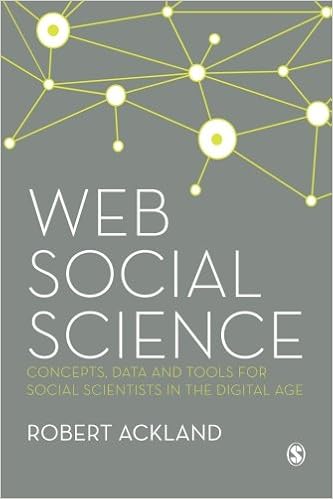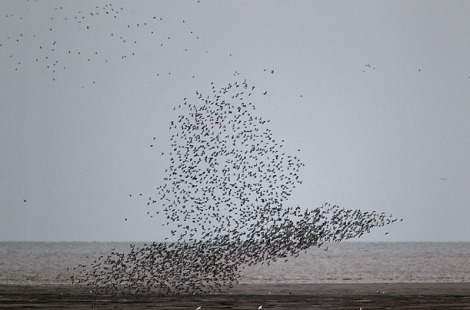Usually we tend to think of the WWW as a tool for research, and I’ll dive into some of the ways that I make use of specific tools to search and mine the web for resources into a later post, but today I wanted to share a bit about how the web can serve as a subject for research. Web social science is the next big thing, with regular sessions now appearing at many major academic society conferences.  If you want to get the big overview, I’d recommend you start with Robert Ackland’s recent book, Web Social Science: Concepts, Data and Tools for Social Scientists in the Digital Age (University users can click here to read the book online via the University of Edinburgh library). Ackland’s book is a terrific resource, covering both qualitative and quantitative modes of research and he covers a large range of tools from online surveys and focus groups, web content gathering and analysis, social media network analysis (which I’ll discuss in a future post), and online experimentation. For an author who is quite technical the book covers a very helpful range of ethical considerations, surveys a range of contemporary methodological literature, and he presents the domain of research involved in each of these which would be accessible to a readership that hasn’t done this kind of work before. A few years ago when I began doing web social science and social network analysis, I found Acklands book to be a terrific catalyst into the wider field of web studies. Continue reading
If you want to get the big overview, I’d recommend you start with Robert Ackland’s recent book, Web Social Science: Concepts, Data and Tools for Social Scientists in the Digital Age (University users can click here to read the book online via the University of Edinburgh library). Ackland’s book is a terrific resource, covering both qualitative and quantitative modes of research and he covers a large range of tools from online surveys and focus groups, web content gathering and analysis, social media network analysis (which I’ll discuss in a future post), and online experimentation. For an author who is quite technical the book covers a very helpful range of ethical considerations, surveys a range of contemporary methodological literature, and he presents the domain of research involved in each of these which would be accessible to a readership that hasn’t done this kind of work before. A few years ago when I began doing web social science and social network analysis, I found Acklands book to be a terrific catalyst into the wider field of web studies. Continue reading
Month: March 2016
Beauty and Truth?
Cross-posted on Wondering Fair
“Beauty is truth, truth beauty,” wrote John Keats in 1819. This celebrated line, still admired as poetry, rings somewhat untrue today. In an age when beauty is often achieved by untruth – Photoshop editing, misleading camera angles,  manipulated statistics – and when truth is often not beautiful – the world’s hunger, meaningless tragedies – the connection Keats noticed between truth and beauty seems today tenuous at best.
manipulated statistics – and when truth is often not beautiful – the world’s hunger, meaningless tragedies – the connection Keats noticed between truth and beauty seems today tenuous at best.
Still, our idea of beauty carries a direct relationship to our ethics. Contemporary eco-philosophers have noticed, for example, that though a person may appreciate the beauty of a mountain range, or of an endangered tiger, this appreciation of beauty does not necessarily lead to a desire for conservation of one’s idea of beauty. If we think of beauty only in terms of our own subjective experience, and not in terms of beauty being embedded in something outside ourselves (i.e. the animal, or flower, or mountain range), the act of preserving beauty turns in on itself. Beauty becomes only subjective. Our primary concern is to sustain our experience of the sublime, not to promote life outside of us.

A different perspective arises when we appreciate beauty as something given to us, not arising from inside ourselves. It generates a consideration of beauty which does not get lost in its own subjective sphere, but which also propels us outward, to active engagement in the world. In a dense but interesting comment on a passage by theologian Hans Urs von Balthasar, David Moss observes,
Where we can no longer read the language of beauty so, for Balthasar, the witness of creation as created becomes untrustworthy and open to abuse… In short, those transitory experiences of the truth, goodness and beauty of the cosmos are intelligible only by way of reference to a transcendent order of Being that is absolutely true, good and beautiful.[i]
In other words, only when we recognize objective beauty, truth and goodness in the world, beyond our own subjective experience of it, can we really be moved to preserve it and to admire the work of their creator.
Among the wide variety of theories of beauty competing for our attention (and operating underneath many contemporary cinematic plotlines), one can make a good case for the “wheels coming off” when social understandings of beauty ceased being based on knowledge of a creator God. The celebration of beauty which remains possible within a nihilistic understanding of the world is deeply problematic, and as Moss suggests, open to abuse and even untrustworthy. To affirm God’s act of creation of the world, with all its beauty and ugliness, provides a stability for beauty that allows us to appreciate it in the context of love and relate beauty to truth.
Jeremy Kidwell
[i] David Moss, “Hans Urs Von Balthasar: Beginning with Beauty”, in David Horrell et all., Ecological Hermeneutics (London: T & T Clark, 2010), 202. In case you’re curious, here’s the passage by Hans Urs von Balthasar (a contemporary Swiss theologian) that inspired Moss: “the world, formerly penetrated by God’s light, now becomes but an appearance and a dream – the Romantic vision – and soon thereafter nothing but music. But where the cloud disperses, naked matter remains as an indigestible symbol of fear and anguish. Since nothing else remains, and yet something must be embraced, twentieth-century man is urged to enter this impossible marriage with matter, a union which finally spoils all man’s taste for love. But man cannot bear to live with the object of his impotence, that which remains permanently unmastered. He must either deny or conceal it in the silence of death.” (Balthasar, The Glory of the Lord, Volume I, (1982) 18-19)
What use is GIS for the humanities and social sciences?
As I’ve mentioned in a previous post about my favourite GIS tool QGIS, geospatial software tends to be used in a rather narrow subset of academic research, i.e. mostly environmental scientists and geologists. The reasons for interest there are somewhat obvious, I think, but this is not as much the case for the humanities and social sciences. I was recently having a conversation with a colleague who asked me why maps might be part of my research toolkit and this got me to thinking. There are some good reasons for researchers to be suspicious of cartography – particularly inasmuch as the “gaze” from above can tend to lend a sense of “mastery” and unwarranted epistemological confidence. James C. Scott conveys this powerfully in his book Seeing Like a State.
However, with a bit of humility in hand, geospatial data can be a terrific tool for learning and teaching. Continue reading
